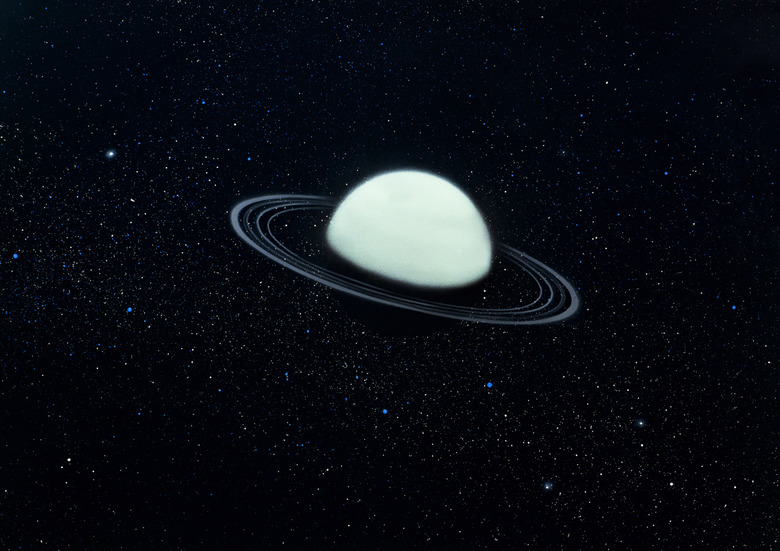What Planet Radiates More Energy Into Space?
All of the planets in the solar system radiate energy into space, but the Jovian planets, which are primarily gaseous, radiate more than they receive, and they all do it for different reasons. The planet that shines the most, relative to its size, is Saturn, but Jupiter and Neptune also radiate significantly more energy than they receive. Uranus, an odd planet in many ways, shines the least of all the solar system's outer worlds, emitting about as much energy as Earth.
Composition of the Outer Planets
Composition of the Outer Planets
The planets that lie beyond the asteroid belt formed differently than the ones closer to the sun. A core of ice and rock probably formed first, and as it grew, its gravitation attracted the hydrogen and helium gases that form the bulk of each planet's atmosphere. As these gases accumulated, they created enormous pressure at the core of each planet, which generated high temperatures. For example, scientists believe the temperature at Jupiter's core is around 36,000 kelvins (64,000 degrees Fahrenheit). The temperatures and pressures are so high in the cores of Jupiter and Saturn that hydrogen exists in a metallic state.
The Heat of Formation
The Heat of Formation
Temperatures in the outer reaches of the solar system are cold. The surface temperature of Jupiter is minus 148 degrees Celsius (minus 234 degrees Fahrenheit) and that of Neptune is minus 214 degrees Celsius (minus 353 degrees Fahrenheit). As a result, the outer planets are cooling off, and part of the energy they radiate is left over from their formation. In the case of Jupiter, which is larger in volume than all the other planets put together, this leftover energy allows it to radiate with an energy that is about 1.6 times what it receives from the sun.
Saturn Is Smaller and Brighter
Saturn Is Smaller and Brighter
Saturn is smaller than Jupiter and farther from the sun, so it should be dimmer, but in fact it shines with an energy that is 2.3 times what it receives from the sun. Scientists believe this extra energy results from a phenomenon called helium rain. Saturn's more rapid cooling allowed helium droplets to form in its atmosphere, and because they are heavier than hydrogen, they fall toward the center of the planet. The friction they generate as they fall through the atmosphere accounts for the extra heat. This explanation also accounts for the lack of helium in Saturn's upper atmosphere.
Neptune Also Glows
Neptune Also Glows
Neptune is the outermost planet, and it generates 2.6 times more energy than it receives form the sun. Because it is so far away from the sun, however, and the sun's heat so weak, this energy output is smaller than the amount of heat that Saturn generates. Little is known about Neptune's internal processes, but one explanation for this phenomenon is that methane is continually being converted into hydrocarbons and diamond, which is a crystalline form of carbon. This conversion releases energy, and it also potentially has created an ocean of liquid diamond surrounding the planet's core.
Cite This Article
MLA
Deziel, Chris. "What Planet Radiates More Energy Into Space?" sciencing.com, https://www.sciencing.com/planet-radiates-energy-space-21764/. 24 April 2017.
APA
Deziel, Chris. (2017, April 24). What Planet Radiates More Energy Into Space?. sciencing.com. Retrieved from https://www.sciencing.com/planet-radiates-energy-space-21764/
Chicago
Deziel, Chris. What Planet Radiates More Energy Into Space? last modified March 24, 2022. https://www.sciencing.com/planet-radiates-energy-space-21764/
